PJ and I have taken about ten days vacation from Via Lucis so that we might enjoy the wonderful recent weather on Cape Cod. Kayaking, boating, fishing, and snorkeling have replaced naves, ambulatories, narthexes and apses, but now we return to our work. Today’s post is about the Alsatian town of Sélestat, located about fifteen miles north of Colmar.
The town is known as the dahlia capital of France (the August Feast of Harvest features a parade with floats decorated with 500,000 dahlias), and is also the birthplace of the Christmas tree. But there is also a wonderful story of the founding of the town. According to the legend, at the dawn of time giants ruled the earth. One of them, stronger and more powerful than the others was called Schletto. He was of huge size with a long black beard and a terrible expression on his face. He dug out the valley of Lièpvrette and tore out the rocks of the mountains to build a fortress. He ruled with an iron fist and forced all the residents of the area move to the town below the fortress – a town named Schlettstadt, or Schletto’s town. When he died, the people rejoiced because Schletto was a hard taskmaster and unpitying.
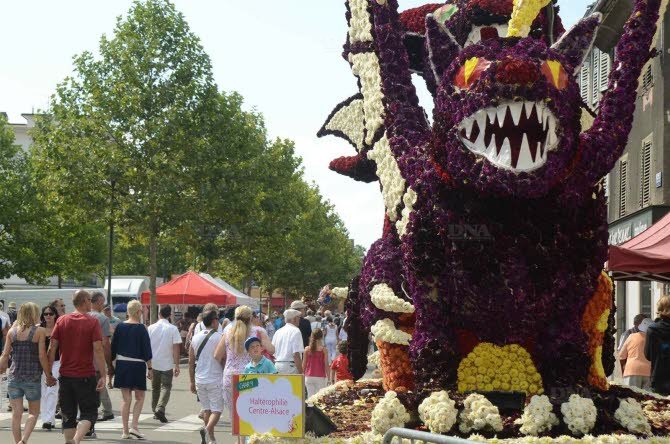
For many centuries, one of his ribs was displayed on the door of the hospital in Sélestat, and later in the library. This mighty relic belonged to a giant over twenty feet tall. In recent years, the bone was discovered to be part of a saurian reptile from the Valley of the Ill. This was another case of science triumphing over a wonderful legend.

What history tells us about the Église Sainte Foy de Sélestat is that it was a Benedictine priory attached to the famous abbey at Conques. Around the year 1087, Hildegarde d’Eguisheim built a chapel dedicated to the Holy Sepulchre which was consecrated by her son, Othon, bishop of Strasbourg, supposedly in penance for an assassination in the episcopal palace. A few years later Othon made a journey to Conques on the pilgrimage road to Santiago de Compostela. That same year he founded the small monastery at Sélestat and attached it to Conques. All that remains of the monastery today is the church, Sainte Foy, in a square in the center of town, but it is a church that was rebuilt in the 12th century.
Sainte Foy is built of red sandstone from the Vosges mountains and is a typical Romanesque structure of the Alsace. It has a deep porch in the west and is flanked by two solid square towers and an octagonal clocher over the transept crossing. Because it was built in such a short time (1170-1180) the basilica-style church is remarkably unified.
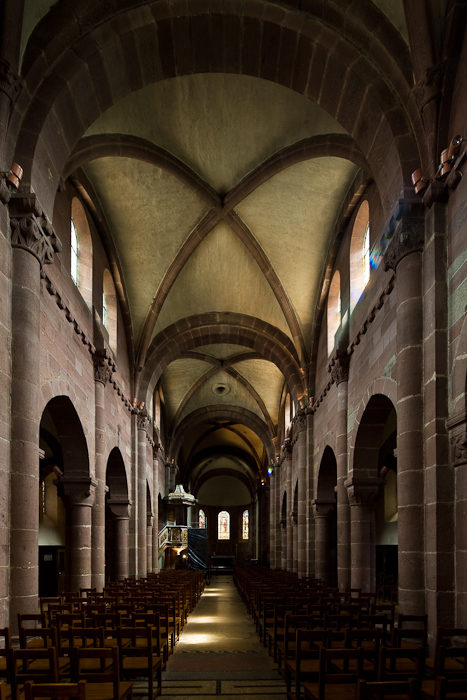
The nave features three double bays with rib vaulting and two clerestory windows on each side. The arcade arches are slightly ogive and are sprung from half-column pilasters on each side of the piers.
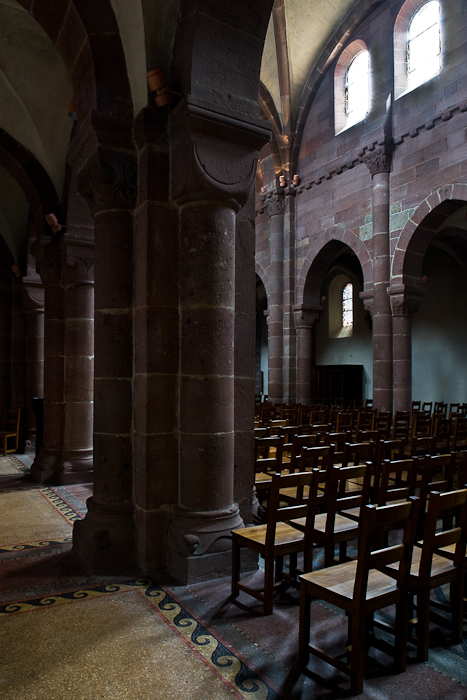
Some of the original Romanesque capitals remain, including this superb example from the nave.
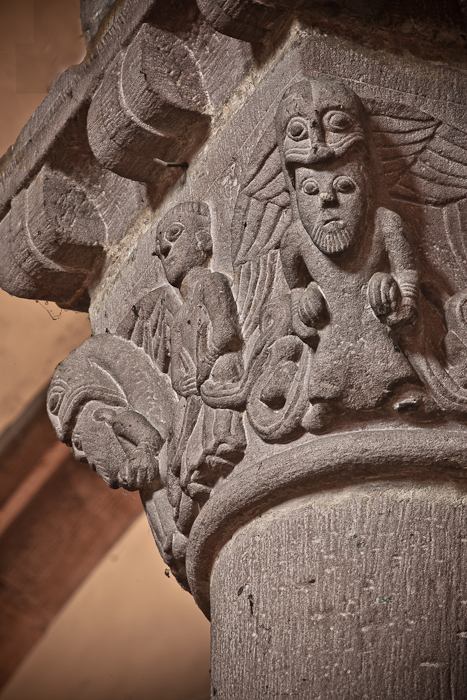
The west portal is a very interesting piece of work, wholly contained within the open narthex. The sculpture is from the 12th century although the doors and the tympanum date from Charles Winckler’s restoration of 1890. The tympanum features Christ in Majesty with the symbols of the four evangalists. Far more interesting to us, of course, were the capitals to the left and right of the door.

The two Atlanteans – the figures of kneeling men – serve as supports to the lintels. Each archivolt is sprung from a finely carved set of capitals. The first set of capitals features paired angels with open books. The others show snakes, winged monsters, and the head of a lion.
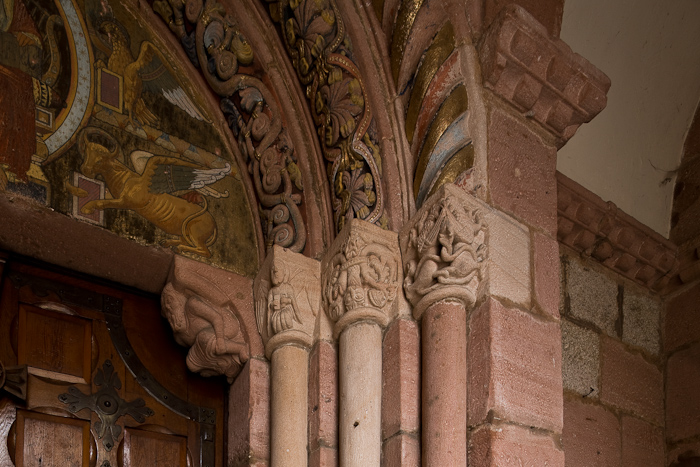
The only part of the original 11th century Saint Sepulchre that remains is part of the crypt. This space is regarded as containting a copy of the tegurium in the Church of the Resurrection in Jerusalem. The tegurium is a form of canopy that originally extended over the statues of Roman deities. The sculpture shown here is 19th Century, placed when the 19th century restoration resulted in the rediscovery of the crypt.
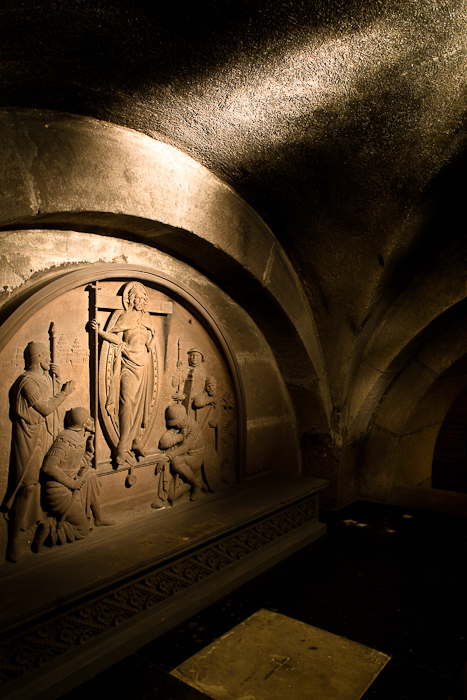
The Église Sainte Foy has experienced significant restorations through the years, including an intelligent program in 1890 by Charles Winckler, an architect of the Patrimoine de France, that resulted in the removal of some unfortunate Baroque additions and returned the church to its Romanesque origins. In addition, more restoration was required after the Second World War because the church was damaged during the Allied advance on the Rhine in 1944.
One Baroque element remains, a lovely painted wooden pulpit added in 1733. The pulpit was listed as part of the Patrimoine de France since 1974. When we were there, an artist was restoring the paint and gold leaf.
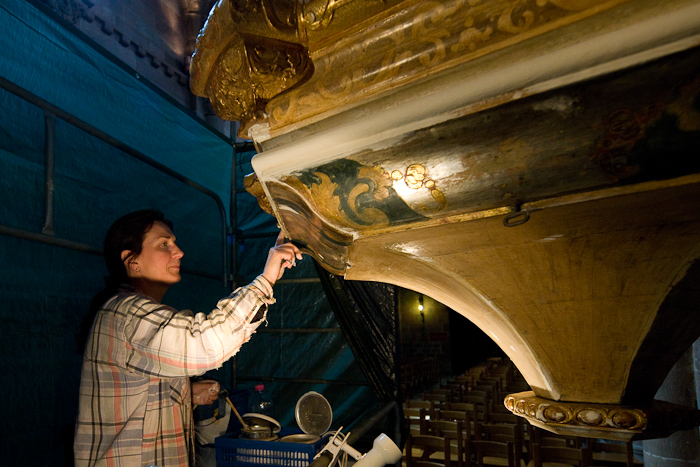
The Église Sainte Foy de Sélestat was one of our favorite churches in the Alsace. I do wish we had seen Schletto’s great rib in the library, however. Perhaps that will be enough to induce us to return in the future.
Location: 48.260086° 7.456801°

love it and i wish i had yr trip -hotter than Dante’s Inferno in se az.,k
K, pretty hot and muggy here in Cape Cod right now. 9:30 at night and I am sweating heavily. We long for the sea breeze right now.
Thank you for this interesting post. My ancestors came to the U.S. after the Franco-Prussian War (when my great grandfather, after the war, given the option of declaring for either French or German citizenship, opted for French citizenship) from the nearby town of Hilsenheim. We visited Selestadt 20 years ago on our way to Hilsenheim, but did not have time to visit the church.
Jay, interesting choice presented after the war. So many chose German citizenship but were French in their hearts.
The crypt shot is fantastic – great light.
As always, excellent shots! Considering that it was connected to the abbey at Conques I would expect there to be more similarities, especially in the nave elevation. Interesting that they jumped straight up to the clerestory and completely omitted the gallery.
Nathan, the Alsatian style of architecture was definitely more Ottonian than Conques, in fact there is a great uniformity in the region. Thanks for your observation.
That does make a lot of sense, thanks for pointing that out.
Nathan, if I remember right, you leave for your great journey in a few weeks. I look forward to hearing more as you wend your way across the world. Please keep in touch.
I will absolutely keep in touch! I don’t have a fancy DSLR camera, just a simple point and shoot, but maybe I can find a bargain somewhere…
Dennis:
Beautiful church. Too bad science had to interfere with the great legend. My grandparents immigrated to the US from the Alsace area of Germany at he turn of the 20th century. What a fought over piece of real estate that has been.
Great website! There was another tyrant of the valley of the Liepvrette. Heinrich Himmler and my father fought there 12-12-44 and won a presidential unit citation when elements of 4 German regiments attacked a very worn out batallion commanded by James Minor of Texas. It was part of the Battle of the Colmar Pocket and the defenders of Selestat were commended by Himmler who crowed….”what the Americans did at Selestat I expect you and your troops to do at Sigolsheim! Look at website The Battle of Selestat Stand Where They Fought to read about Schletto’s descendant. Sincerely, GregColmar@hotmail.com
Thanks, Greg, for the information. I have studied the German offensive at the Colmar pocket but have never come across the website you referenced. I’ve posted it here so that people who are interested can go directly there. BTW, Audie Murphy won his Medal of Honor in that battle, at Holtzwihr, just 10 miles south of Sélestat.